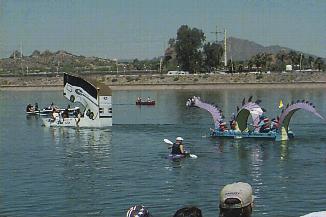Dreamboat

studio fundamentals: To introduce structural design principles as applied to three-dimensional problem solving.
concepts: to explore the possibilities of functional and expressive form within strict material and process limitations. To explore the realm of dreams and fantasy through sculptural form.
technical: to understand the functional requirements for literally "floating your boat."
Project References
Materials
Preliminary:
1. Before coming to class read the concept area of Fantasy and the Unit VIII Discussion on Structures in the 3D matrix. Check out the Unit references.
2. Do some research in the library and on the Web in the area of "boat design." Look in particular for boats that emphasize "pleasing lines," symbolic references, or possess unique sculptural characteristics.
Activities/considerations:
a) Make some initial "thumbnail sketches" of some boats you feel were interesting from your research.
b) Identify and design the key features that will make up the structural components of your sculpture. You will make a scale model of your boat in index bond paper (or thin styrene).
c) How can the functional requirements of your sculpture be integrated with the imagery you have selected? What materials, colors, supplemental surface markings, types of connectors, symbolism, figuration are appropriate?
d) See the steps for building
a real cardboard boat in the following web link from the Great Cardboard
Boat Regatta: http://www.gcbr.com/tips.html
d) Using your initial research, your thumbnail sketches, and your finished
sculpture as resources, write a page that discusses your ideas and the
final project. Put this page into your notebook.
e) Caution: Consider doing this process as a collaborative exercise. This is a very challenging project requiring a lot of hours of labor to pull it off.
Critique Ideas
When
you have completed your sculpture, pair up with another artist and trade
critiques. Consider the following:
1. Describe the techniques used to create the sculptures and explain how
various aspects of the problem were addressed such as material choice,
the problems specific to boat design, the integration of structural and
aesthetic issues, etc.
2. How does your "dreamboat" compare with other boats you have seen?
3. Discuss ideas the artwork seems to communicate. After some sharing of interpretations, attempt to describe the effect of the work in one sentence. (This artwork is about...)
4. Test it! We will participate as a class in the Great Cardboard Boat Regatta / Rotary River Rally on a Saturday in April (Exact date TBD). Location: Tempe Town Lake
Notebook
Your notebook should include
the following:
1. Evidence of your research (print-outs from magazines, web searches,
interviews, etc.).
2. Your design process (drawings, computer-printouts, photos, etc).
3. Supplemental materials (receipts, notes about techniques or materials)
4. Documentation of the final work and, if possible, a video clip of your boat in the water. Consider translating video clip into "Quicktime" movie suitable for viewing over the Web.
